Displaying items by tag: boatyard
Boatyard Bliss, Where Owners Can Work On Their Craft
#boatyards – The interface between sea and land is infinite in its variety, and attractive to modern man as somewhere interesting to live. So if you set up a little coastal boatyard almost anywhere, very soon you'll be told that the property would be much more valuable if it was re-developed for residential use. Thus in Dublin, while we're more than happy to go along with the ancient north-south Liffey divide (Vikings to the north, Normans to the south, and the Irish somewhere out in Kildare), the reality is that in terms of property values, the divide is east-west, though admittedly with added north-south undertones.
This is fine and dandy for real estate theorists and the happy owners of desirable property near the coast. But with layup time and winterising schedules upon us, it makes life increasingly difficult for the dwindling band of boat owners who try to do their own boat maintenance and modification, and may even have built their boat from scratch in the first place, or at least from a bare hull.
Such people – and I'm one of them – operate in a different world. We amateurs working on boats, we barely qualify as a genuine economic activity. Our wives (very few of whom get directly involved) quite rightly dismiss it all as foostering. As for the rest of the community, we amateur bodgers are an embarrassment. We're out of sync with the new reality. These days, we live in an increasingly specialised society, where the preferred location for boat-building is in a purpose-built factory many miles inland where the land is cheaper, while waterfront servicing and repairs are swiftly executed in state-of-the-art units, where throughput has to be rapid and efficient.
Delays are anathema to people running these successful waterfront businesses. But delays and leisurely contemplation are essential for the DIY boat bodger, as he may eventually think of a much better way of coping with a problem which would have been dismissed as intractable by the professional, whose solution would have been the complete replacement of the troublesome item, and probably the complete replacement of the entire boat, all done before close of business that day.
The boat bodger doesn't think in terms of days, let alone close of business. All he needs is all the time in the world, and his own little space. In most modern coastal communities, neither is available. So we wax nostalgic about traditional yards where the boats came up a slip (at least a day's work in itself), and the work schedule stretched gently into the infinite beyond.
Every so often we still come across such places, and if we're on other business in the area, I am expressly forbidden from going near these paradises for boat nuts, as they're very heaven, and I'd be lost for the rest of the day But you won't find any in Dublin, where boat life now is all travel hoists and cranes and strictly scheduled throughput, while people think a slip is something that happens on a banana skin. However, if you get way from the big urban centres, there's more chance of finding yards which somehow retain enough of the traditional mood to relax the stressed boat owner, while at the same time embracing enough of the present to stay in business. And they're filled with boats which are themselves a living history of yacht design.
Perhaps the most remarkable boatyard place in Ireland is around Oldcourt in West Cork, where the Ilen River comes conveniently near the road as it meanders on its way down from Skibbereen to Baltimore. Several marine-related businesses seem to overlap here, there are boats of all shapes and sizes, and there are certainly some craft for which this is the final port of call. But as Spring arrives, somehow the numbers ashore get less, the number of emptied cradles increases, and despite the unhurried atmosphere, a lot gets done.
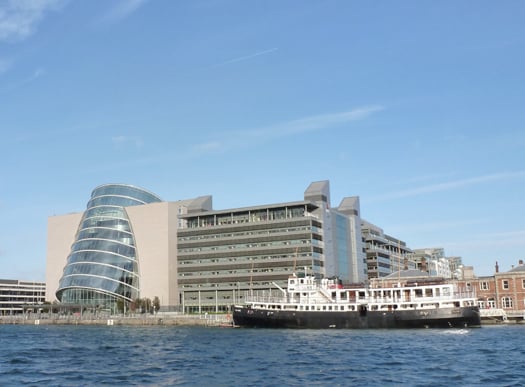
Oldcourt achievement. The Cill Airne restaurant ship in Dublin was successfully converted for her new function at Oldcourt on the River Ilen in West Cork. Photo: W M Nixon
A remarkable Oldcourt achievement was the conversion of the Cill Airne, the restaurant ship now berthed in the heart of Dublin. Originally, she was Cork Harbour's tender to take passengers out from Cobh to great liners, and then she was a training ship for the marine academy. Her active seagoing career finished, she still had plenty of life in her for a new existence as a restaurant boat, but a conversion job in an orthodox dockyard would have been prohibitively expensive. Somehow they managed to get her up the river and alongside at Oldcourt, and once there, were able to take their time for a very fine job. In all, 132 different tradesmen, recruited mostly in West Cork, worked on the Cill Airne in the Ilen River. This past summer, when she was the focal point for the Riverfest during the Old Gaffers Golden Jubilee visit to Dublin, the boat-bodging gaffers were completely charmed to learn that this fine conversion had been done at an old-fashioned boatyard, just like the kind of place they dream of locating their own boats, if only they could find it in their area.
The heart and soul of Oldcourt, the warm spirit of the place, is embodied by the continuing restoration of the Ilen, the Conor O'Brien ketch which Gary MacMahon brought home from the Falklands quite a few years ago now. Her gentle restoration is an end in itself, and a balm for the soul. Love of wood is inherent in most of us, as an affinity for wood and an instinct to do something useful with it was a key survival mechanism at an important stage of human evolution. So it is still part of our makeup, and the Ilen restoration shed is a place of healing and mental comfort.
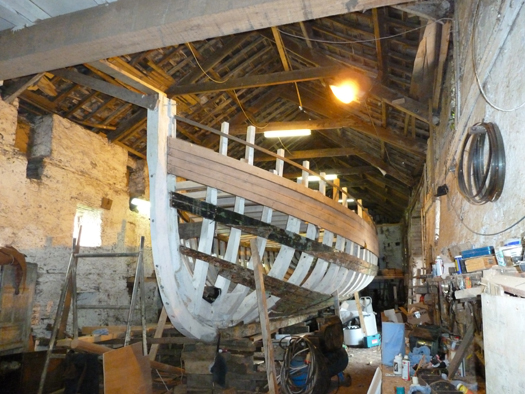
Sweet work. The restoration of Ilen has been a reassuring feature of life in Oldcourt for some time. Photo: W M Nixon
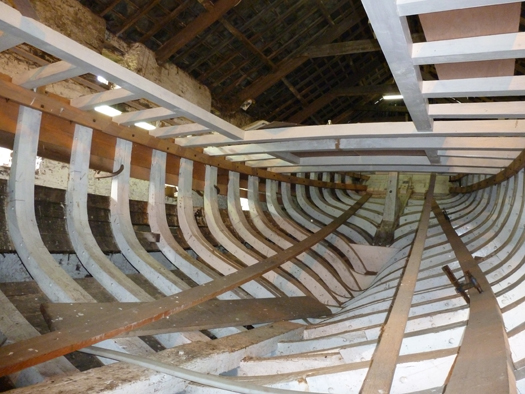
An early stage of the Ilen's restoration. Photo: W M Nixon
Up in the northeast of Ireland, hidden away behind the islands along the west side of Strangford Lough, is Billy Smyth's boatyard at Whiterock. If you were a film producer and requested your location scouts to find the classic traditional small boatyard to make a movie about sailing in times past, they would become ecstatic about Billy Smyth's. It's very basic yet remarkably efficient, while the quality of the work done by Kenny Smyth and his team is first class. And inevitably, there's the usual small quota of boats whose owners don't seem to want them launched now and again, and some from one year to the next. For some time, I'd been trying to trace a John B Kearney-designed 1936-built 6-ton yawl, the Rosalind, which had last been reported in the Poole area in the south of England many years ago. She'd gone under the radar, but she turned up this past summer in Billy Smyth's, where she has been under a cover for years in a corner of the yard, her owner's intention unfathomable.
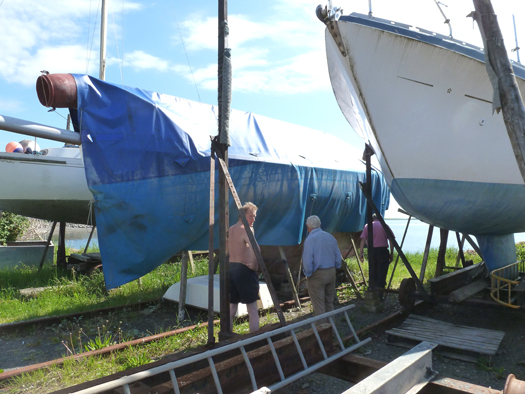
Just another boat under a cover in the corner of a boatyard...Photo: W M Nixon
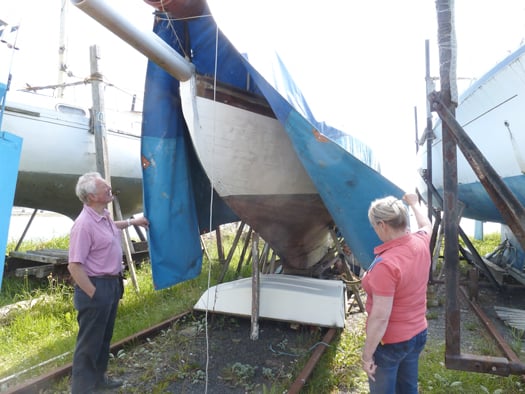
....but as the cover was hauled back......Photo: W M Nixon
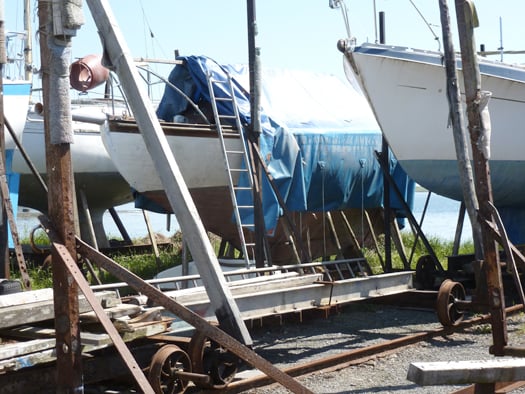
.....the 1936 John B Kearney 6-tonner Rosalind was revealed. Photo: W M Nixon
You may well think that it's only in Ireland that you can still find these gems of living boatyard history, but in the summer we were at the head of the Helford River in Cornwall, and found ourselves in the midst of the easygoing maritime mayhem which is Gweek.
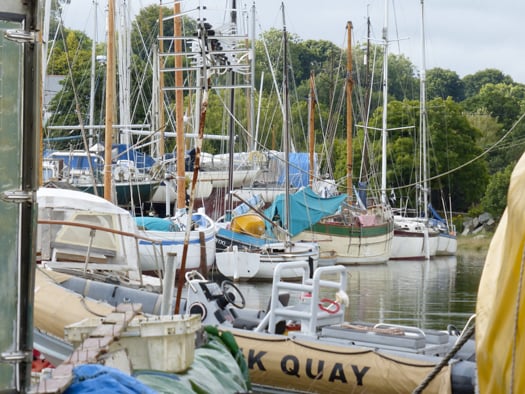
At the head of the Helford River estuary in Cornwall, Gweek Quay is a place of promise and fascination. Photo W M Nixon.
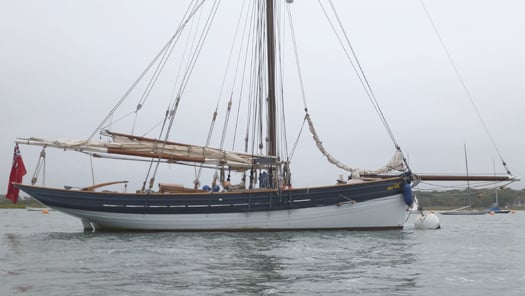
Gweek is renowned as the birthplace of several Luke Powell pilot cutters. This is the Agnes, built in 2002 and based on a Scillonian pilot cutter of 1841. Photo: W M Nixon
In recent years, Gweek has been best known as the place where Luke Powell built his renowned Pilot Cutters, whose lines are unchanged from the mid-19th Century. But there's much more to Gweek than that. If your perception of England is of an over-regulated place where nothing much can happen without some peak-capped official's say-so, Gweek is an eye opener. Basically it's a creekhead boatyard, where the yard is filled with an astonishing variety of craft, many of them character boats, and some of which haven't been launched for a very long time.
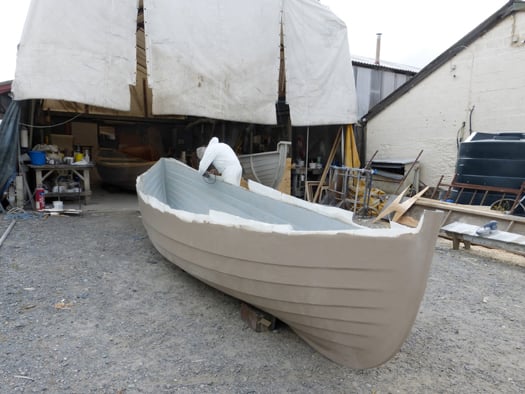
Serious work. GRP gigs emerge from the moulding shop at Gweek. Photo: W M Nixon
There's an unmistakable air of amiable anarchy, yet with underlying purpose. Some sheds were busy while we were there, finishing GRP double-ended gigs. Nearby was a large pop-up tent of a boatshed, and a looksee inside revealed it held the famous classic offshore yawl Lutine, restored recently at Gweek and taking a season off from seafaring. And all around another part of the creek, there were the houseboats.
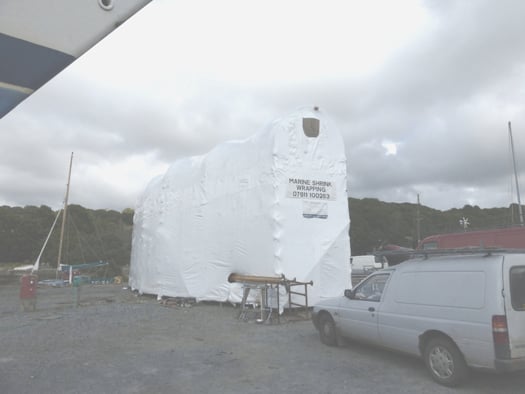
A pop-up boatshed invited a look inside.....Photo: W M Nixon
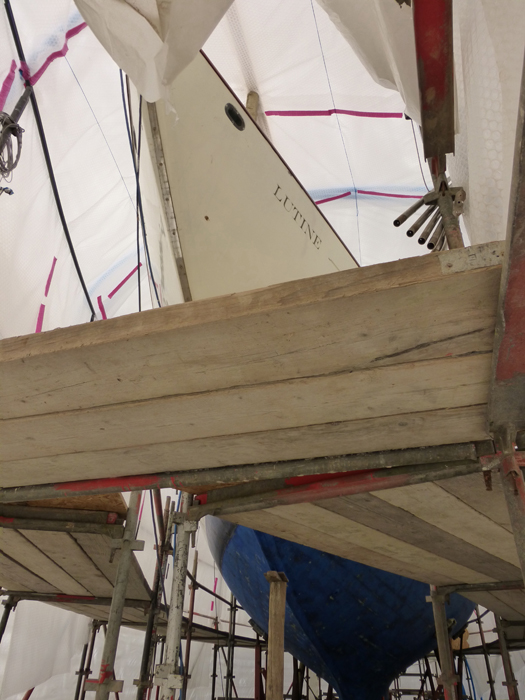
...and we weren't disappointed. It was the classic offshore racing yawl Lutine. Photo: W M Nixon
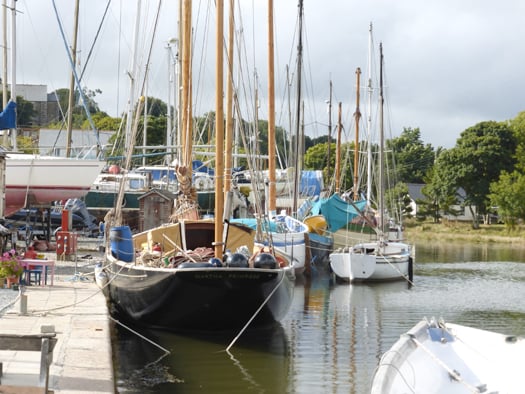
At Gweek, classic yachts share space with more humble craft....Photo: W M Nixon
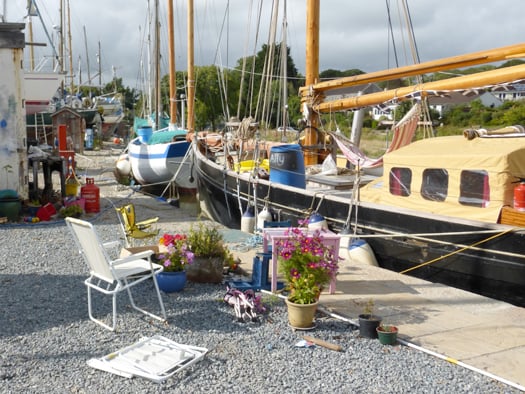
....and the owners are determined to have domestic comfort while in port. Photo: W M Nixon
Clearly, the houseboats, both in their location and appearance, are subject to no planning requirements whatever. Ancient hulls had their upperworks extended in stratospheric style. What looked like a former River Thames lighter in beside the trees had a three storey structure atop it like a Missisippi riverboat. And yet they weren't the last resort of people desperate for somewhere to live. Judging by the cars parked about the place, living in houseboats – however odd - was a lifestyle choice made by people who could well afford to live ashore.
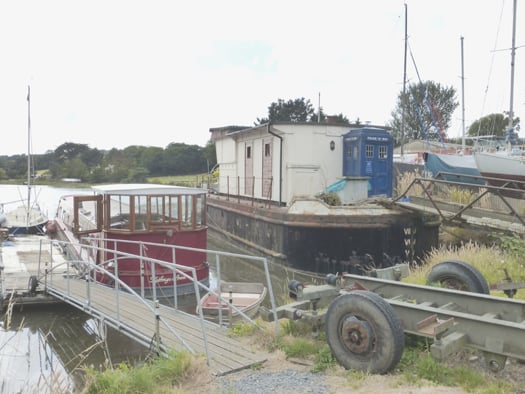
The houseboats in Gweek are a study in themselves. Note the "office & facilities block" on right, complete with public phone Photo: W M Nixon
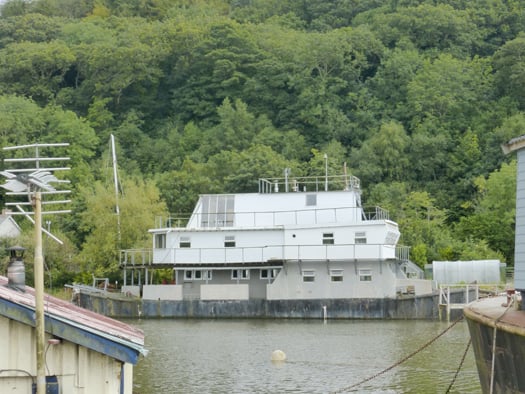
With no apparent planning restrictions, the Gweek houseboats can go for height........Photo: W M Nixon
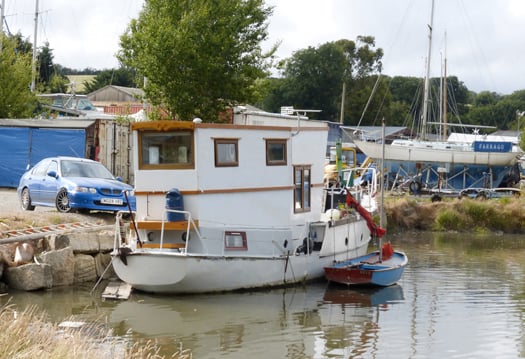
....even on boats where you wouldn't expect it. Photo: W M Nixon
So it's all of a piece that for some glorious years, the yard in Gweek was where Luke Powell built his cutters. They're arguably of an even older design type than the Galway Hookers, yet like the Connemara boats, they attract a passionate following, people who would sail on no other boats, and in a contemporary anchorage, a Powell cutter will certainly stand out, a glorious blast from the past.
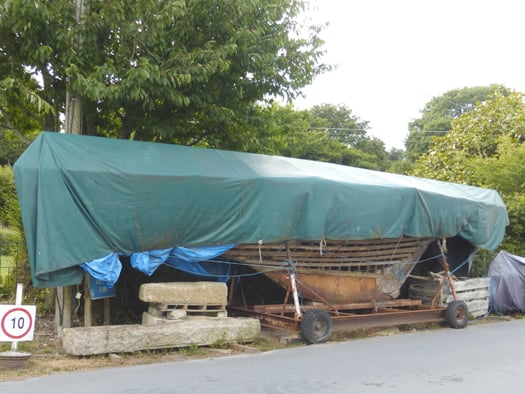
Not all Gweek projects are showing signs of progress. This may have been an International 6 Metre once upon a time, but she needs a lot of attention. Photo: W M Nixon
Blasts from the past were the theme of another boatyard visit, this time to Gloucester where the Severn winds its way between the Malvern and Cotswold hills. If you follow the doings of the tall ships, you'll know that T. Nielsen & Co's yard at Gloucester is the place to get sailing ship problems put right, and the yard in the midst of the historic docks in Gloucester has deservedly acquired a high reputation for serious work.
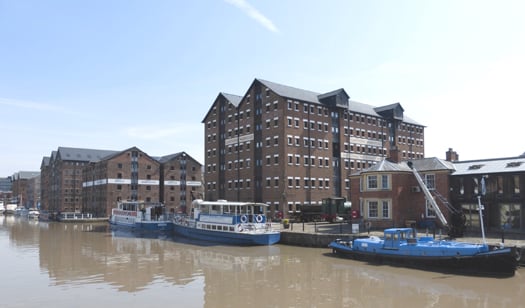
Gloucester's historic docks provide a home for the Nielsen company, specializing in work on tall ships. Photo: W M Nixon
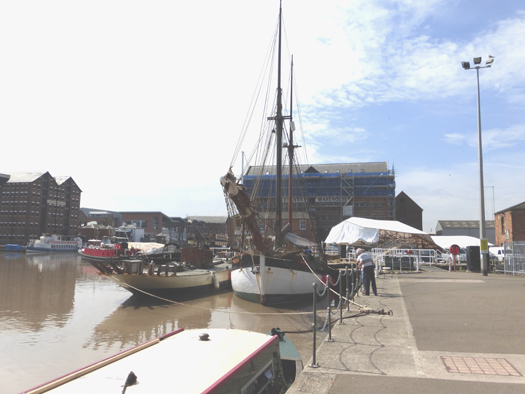
There's always something of interest in the Nielsen corner in Gloucester, in this case a Victorian yacht awaiting restoration beside a Baltic ketch, while in the foreground is a narrowboat from the English canals. Photo: W M Nixon
This is big boy's territory – you get an appreciation of the scale of the Nielsen operation by realizing that one of the smallest craft they've worked on in Gloucester recently was the 52ft 1911-built Bristol Channel Pilot cutter Hirta, which had a complete re-build to emerge as new, and under her original name of Cornubia. A long time ago, Hirta was owned by Tom Cunliffe, who bought her in Scotland in 1982 and called into Howth on his way south at the beginning of a very productive partnership which included a Transatlantic cruise by the northern route. But pilot cutters, like Galway Hookers, weren't built of materials which were expected to last for ever, so it's good news that the Cornubia had this re-build completed in 2010, and is now based at Plymouth under the ownership of the Bristol Channel Pilot Cutter Trust.
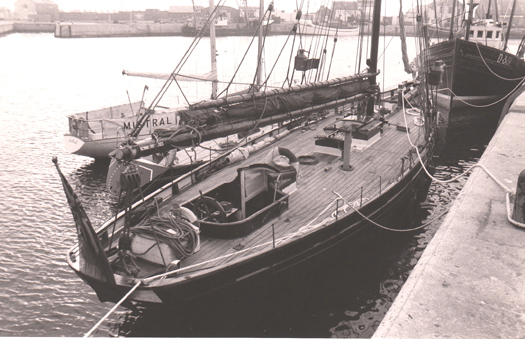
The 52ft pilot cutter Hirta in Howth in 1982. She has recently been re-built in Gloucester, and now sails under her original name of Cornubia. Photo: W M Nixon
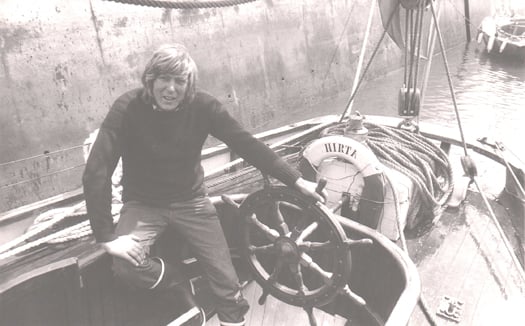
Tom Cunliffe, distinguished maritime writer and former President of the Old Gaffers Association, aboard Hirta in Howth in 1982. Photo: W M Nixon
The Nielsen people were in more familiar size territory when they did the lofting and made the rig for the Jeanie Johnston, and when we were there, they were busy with a major restoration on the Kaskelot, the three-masted 153ft Danish-built barque which was in one of the two dry docks, while other interesting craft at various stages of work were afloat in the dock.
Gloucester is where the heart of the country interacts with the sea, but in order to reach it from the Bristol Channel, vessels have to transit the long ship canal along the Severn valley up from Sharpness, which means that when you reach Gloucester, there's no question of people being impatient to nip out for a day sail – this is a place for working at seagoing ships. Yet Gloucester is also a port on England's myriad of inland waterways, in fact for a period it was an unrivalled entrepot for waterborne trade. But the historic docks are so perfect in their completeness that you get the feeling the burghers of Gloucester must have been on the very cusp of finishing this state-of-the-art waterways centre just as the railways were beginning to make such places redundant, and subsequent generations must have been tempted to flatten the impressive warehouses and fill in the basin.
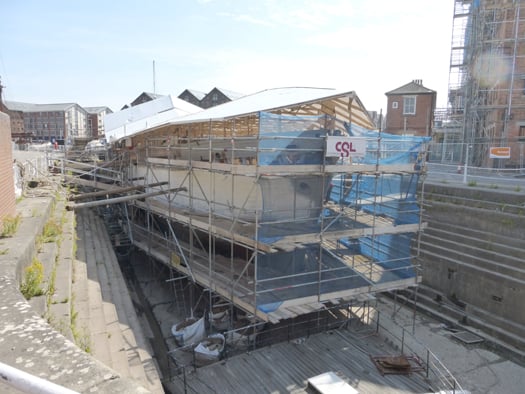
The three-masted barque Kaskelot undergoing major work in one of the Gloucester dry docks. Photo: W M Nixon
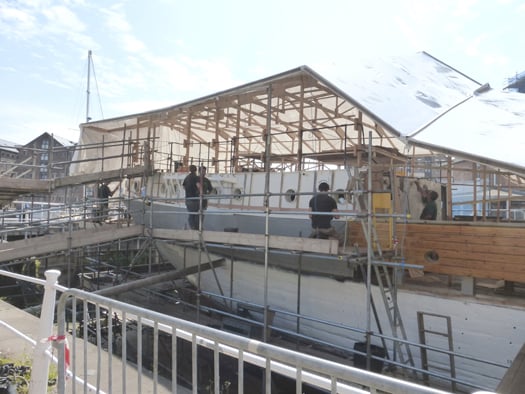
Even on a Saturday morning, there's plenty of work going on for tourists to watch.....Photo: W M Nixon
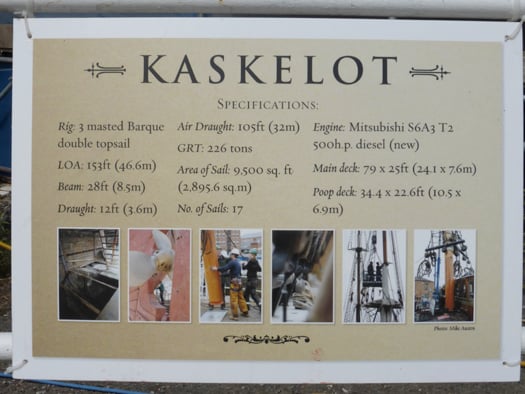
.....and there's a helpful information board to give you the dimensions of the ship in the dry dock.......Photo: W M Nixon
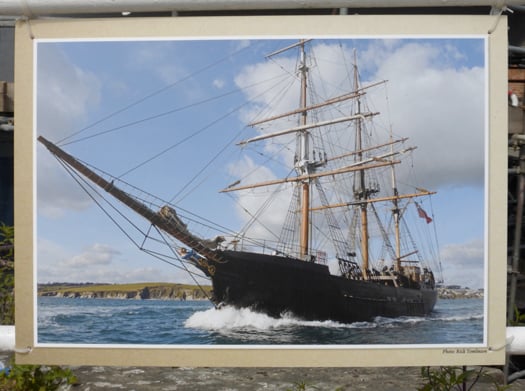
....and there's even a photo to show you what she'll look like when the job is finished. Photo: W M Nixon
But miraculously Gloucester docks have survived, and not least of the elements in their current regeneration is the interest and energy of the Nielsen yard. We were there on a Saturday morning, yet they were busy on the Kaskelot. I didn't dare ask if it was a stipulation of their contract for having the use of the quayside and the dry docks, that they should continue working through the weekend when visitors are about. No doubt about it, the public loves work – they could watch it all day. And what used to be demanding and sometimes dangerous work is now a matter of recreational viewing. Who knows, but some time in the distant future, the government of Bangladesh may think it sensible to pay grants to the families who currently break up ships by hand on the shore of the Indian Ocean, in order to encourage them to continue their lethal but fascinating work for the edification of tourists.
Rossbrin Boatyard in Schull, Co. Cork. Boat Storage, Repair and Maintenance
Rossbrin Boatyard is based in Schull, Co. Cork and was established in 1984.
Services include Boat storage, boat sales, boat hire aswell as the following:
Safe Winter Lay-up
Full Facilites
Personal Service
Reliabilty
Competitive Rates
Sheltered Boat Storage
Slipway and 16 ton Boat Hoist
Custom-built Workshops
Owner-managed Company
English and German Spoken
www.rossbrin-boatyard.com
Phone: +353(0)28 37352
Email: [email protected]
Hugh Mockler Joins Crosshaven Boatyard
Crosshaven Boatyard Company Ltd has announced that Hugh Mockler, (formerly of HM Yachts Ltd), is to join long established yacht broker, Donal McClement in the Boatyard's new boat and brokerage sales division.
Matt Foley, General Manager of Crosshaven Boatyard, told Afloat, 'Donal and Hugh are two of the best known and most successful Yacht Brokers in Ireland. Over the past number of years and their combined knowledge of a very difficult market will ensure that the buyers and sellers get a top class service'. Hugh and Donal will be able to give buyers and sellers the best possible advice.'
Crosshaven Boatyard has been providing marine services for over 60 years.
The boatyard also specialises in all aspects of the repair and maintenance of modern pleasure boats. Many well-known boats such as Gypsy Moth V, the Saint Brendan, Longbow II and a series of Moondusters were completed in the1980s.
It was the first commercial marina, with a marine travel hoist, in Ireland in 1979. The yard is the Irish distributor for Dufour Yachts of France, and Grand Soleil, of Italy.
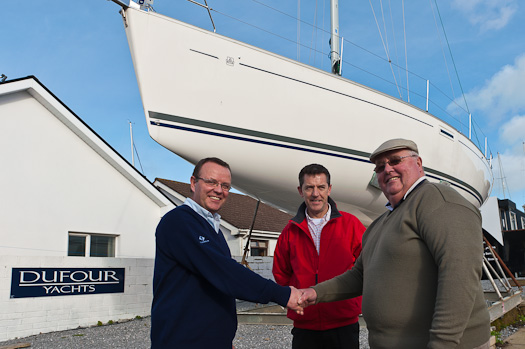
Hugh Mockler (left) is greeted by General Manager Matt Foley (centre) and yacht broker Donal McClement. Photo: Bob Bateman
Castlepoint Boatyard
Castlepoint Boatyard is based in Crosshaven, Co. Cork, it offers the following services...
25 Tonne Travel Hoist
• Wood and GRP Repairs
• Respray, Coppercoat and
• Osmosis Treatments
• Bow Thruster and Heating
• Agents for Mermaid Diesel Engines
• Winter Storage
• Maintenance and insurance work
New 25 Tonne Travel Hoist
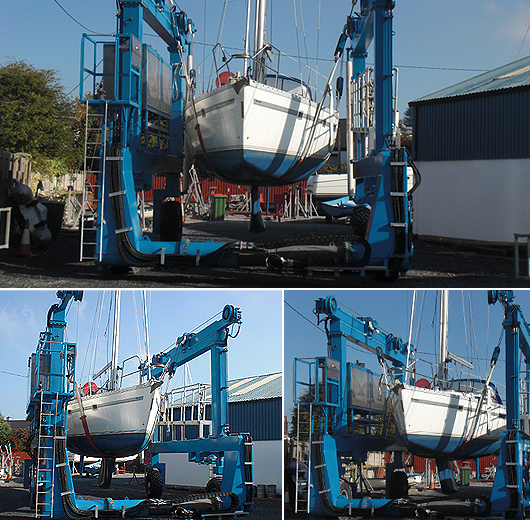
Crosshaven,
Co. Cork
Tel: 021 4832154
Email: [email protected]






























































